Biomass Resources and Biofuel Technologies: A Focus on Indian Development
Abstract
1. Introduction
- They can be extracted from biomass, producing biofuels from organic materials such as plants, agricultural residues, or other biological sources.
- They are biodegradable: Biodegradable fuels have the ability to spontaneously decompose in the environment over a period of time. They undergo decomposition and reintegrate into the natural cycle without producing persistent damage or contamination, rendering them a more ecologically sound substitute for some traditional fossil fuels that do not readily undergo biodegradation.
- Biofuels, generated from renewable biological sources such as plants and algae, can be manufactured and utilized in an ecologically and socially sustainable manner. They combust based on the carbon dioxide cycle.
- Environmentally friendly: The environmental friendliness of biofuels can vary depending on factors such as feedstock choice, land-use practices, and production methods. Some biofuels, particularly those produced from food crops, have been associated with negative environmental impacts, such as deforestation, habitat loss, and competition with food production.
2. Biomass
2.1. Biomass Sources for Energy
- ❖
- Wood and waste products from wood processing, such as wood chips and pellets, firewood made from timber, sawdust, and trash from pulp and paper factories.
- ❖
- Sugarcane, corn, soybeans, woody plants, crop residues, switchgrass, and algae are examples of agricultural crops and waste materials.
- ❖
- Municipal solid trash contains biogenic elements like cotton, paper, food, yard waste, and wool products.
2.2. Biofuel Productions and Its Uses
3. Classification of Biofuel on Generation Basis
3.1. First-Generation Fuel
3.2. Second-Generation Fuel
3.3. Third-Generation Fuel
3.4. Fourth-Generation Biofuels
How Fourth-Generation Biofuel Production Works
- Algae, as an example, are genetically engineered to absorb enormous quantities of carbon; they are cultivated and extracted for bioenergy.
- The agricultural products are then converted into gasoline using second-generation technologies.
- Carbon is captured during the pre-combustion stage of gasoline production.
- The atmospheric carbon becomes geo-sequestered, which means it is stored in non-mineable coal reserves or exhausted natural gas and oil reservoirs. It will remain buried and protected for tens of thousands of decades.
4. Bioresources
4.1. Terrestrial Resources
4.1.1. Jatropha
4.1.2. Agricultural Byproducts
4.1.3. Energy Plants
4.2. Marine Resources
4.2.1. Seaweed or Macroalgae
4.2.2. Microalgae
4.2.3. Cyanobacteria
5. Further Classification of All Biofuels into Two Categories
5.1. Conventional Fuel
5.2. Advanced Fuel
5.3. Alternative Biofuels
6. Products of Biofuel Process
6.1. Biodiesel
6.2. Biobutanol
6.3. Bio Ethanol
6.4. Biohydrogen
6.5. Bio-Oil and Biogas
6.6. Biomethanol
7. Biotechnological Improvement of Algal Biofuel
7.1. Biotechnology for Enhancing Lipid, Starch, and Fatty Acids Synthesis
7.2. Genetic Engineering for Carbon Capture and Lipid Accumulation Ability
7.3. Biohydrogen Production through Genetic Engineering
8. Nanotechnology for Biofuel Production
8.1. Metal and Metal Oxide NPs
8.2. Magnetic Nanomaterials
8.3. Acid-Functionalized Magnetic Nanoparticles
8.4. Carbon Nanotubes (CNTs)
9. Lanzajet Technology for Biofuel Production
10. Microwave Technology
11. Ultrasonic
12. Biofuel Production Process
- Pyrolysis is a thermochemical process that involves the decomposition of biomass in the absence of oxygen, resulting in the production of bio-oil and biochar.
- Hydrothermal liquefaction is a process that involves the conversion of wet biomass, such as algae, sewage, or a liquid slurry of feedstock, into bio-oil.
- Gasification is a process wherein biomass undergoes a purification and preparation procedure to convert it into a fuel. This involves subjecting the biomass to elevated temperatures in the presence of oxygen or steam, resulting in the production of hydrogen gas.
- Hydrolysis: To produce fuels or compounds that can be turned into fuels, biomass is first physically or chemically treated to break down the structure of plant cell walls. Plants are broken down to produce sugars. The efficiency with which cellulose is transformed into glucose, or sugar, may depend on the efficacy of pretreatments to alter the material’s structure and chemistry.
- Fermentation: Yeast performs a fermentation process, which is an anaerobic biological activity that converts sugars into alcohol [71]. Saccharomyces ceveresiae and other commercial yeasts are used to ferment sucrose. The invertase enzyme in yeast initiates glycogen and sucrose biosynthesis. Secondly, the yeast produces ethanol from fructose and glucose thanks to an enzyme called zymase.
- Gasification: To create gases such as carbon dioxide (CO2), hydrogen (H2), and carbon monoxide (CO), gasification can be used on organic carbonaceous resources. The gasification reaction involves several different thermal reactions, including drying, pyrolysis, combustion, and reduction. The gases produced in this process are known as syngas. Biomass gasification is commonplace in the energy industry due to the production of syngas (synthesis gas), hydrogen (H2), methane (CH4), and other valuable byproducts. The process requires heating organic materials to extremely high temperatures (600–1500 °C) in the presence of a measured amount of oxygen and/or steam. Gas engines can use the manufactured gas to create more H2 and methyl (CH3OH), or it can be processed into synthetic fuel using the Fischer–Tropsch method.
- Drying: The first step in this process is drying the biomass before moving on to the pyrolysis phase.
- Pyrolysis: Char, tar gases, and liquids are produced when the biomass raw material is treated with high temperatures (typically exceeding 240 °C) in an air-free environment.
- Combustion: Tar fumes or char from pyrolysis are typically used as the first catalyst. Drying, pyrolysis, and reduction are only some of the additional processes that can benefit from the heat recovered by heat recovery systems from the combustion process. Cracking occurs when heat causes huge, complicated particles to break down into smaller, simpler particles; for example, when tar molecules are split down into lighter, simpler molecules. This process is essential for optimum combustion, and it also has the added benefit of creating an enhanced and uncontaminated gas that might be used in internal combustion engines.
13. Sustainability and Circular Bioeconomy of Biofuel Production
14. Conclusions
Funding
Data Availability Statement
Acknowledgments
Conflicts of Interest
References
- Escobar, J.C.; Lora, E.S.; Venturini, O.J.; Yanez, E.E.; Castillo, E.F.; Almazan, O. Biofuels: Environment, technology and food security. Renew. Sustain. Energy Rev. 2009, 13, 1275–1287. [Google Scholar] [CrossRef]
- Gaurav, N.; Sivasankari, S.; Kiran, G.S.; Ninawe, A.; Selvin, J. Utilization of bioresources for sustainable biofuels: A Review. Renew. Sustain. Energy Rev. 2017, 73, 205–214. [Google Scholar] [CrossRef]
- IEA. Global Energy Review: CO2 Emissions in 2021; IEA: Paris, France, 2022; License: CC BY 4.0; Available online: https://www.iea.org/reports/global-energy-review-co2-emissions-in-2021-2 (accessed on 15 May 2023).
- Mosnier, A.; Havlik, P.; Valin, H.; Baker, J.; Murray, B.; Feng, S.; Obersteiner, M.; McCarl, B.; Rose, S.; Schneider, U. The Net Global Effects of Alternative U.S. Biofuel Mandates: Fossil Fuel Displacement, Indirect Land Use Change, and the Role of Agricultural Productivity Growth. Energy Policy 2013, 57, 602–614. [Google Scholar] [CrossRef]
- Wang, X.; Li, C.; Chen, M.; Wang, J. Microwave-assisted pyrolysis of seaweed biomass for aromatics-containing bio-oil production. In Proceedings of the 7th International Conference on Energy Materials and Environment Engineering (ICEMEE 2021), Zhangjiajie, China, 23–25 April 2021. [Google Scholar]
- World Resources Institution (WRI). This Interactive Chart Shows Changes in the World’s Top 10 Emitters. 2020. Available online: https://www.wri.org/insights/interactive-chart-shows-changes-worlds-top-10-emitters (accessed on 11 May 2023).
- Ganzenmüller, R.; Pradhan, P.; Kropp, J.P. Sectoral performance analysis of national greenhouse gas emission inventories by means of neural networks. Sci. Total Environ. 2019, 656, 80–89. [Google Scholar] [CrossRef] [PubMed]
- Intergovernmental Panel on Climate Change (IPCC). Climate change 2013: The physical science basis. In Contribution of Working Group I to the Fifth Assessment Report of the Intergovernmental Panel on Climate Change; Stocker, T.F., Qin, D., Plattner, G.-K., Tignor, M., Allen, S.K., Boschung, J., Nauels, A., Xia, Y., Bex, V., Midgley, P.M., Eds.; Cambridge University Press: Cambridge, UK; New York, NY, USA, 2013. [Google Scholar]
- FAO. World Food and Agriculture—Statistical Yearbook 2023; FAO: Rome, Italy, 2023. [Google Scholar] [CrossRef]
- FAO IFAD; UNICEF; WFP; WHO. The State of Food Security and Nutrition in the World 2018. Building Climate Resilience for Food Security and Nutrition; FAO: Rome, Italy, 2018. [Google Scholar]
- Cayuela, M.L.; Kuikman, P.; Bakker, R.; van Groenigen, J.W. Tracking C and N dynamics and stabilization in soil amended with wheat residue and its corresponding bioethanol by-product: A 13C/15 N study. GCB Bioenergy 2014, 6, 499–508. [Google Scholar] [CrossRef]
- Bera, B.; Bhattacharjee, S.; Sengupta, N.; Saha, S. Dynamics of deforestation and forest degradation hotspots applying geo-spatial techniques, apalchand forest in terai belt of himalayan foothills: Conservation priorities of forest ecosystem. Remote Sens. Appl. Soc. Environ. 2021, 22, 100510. [Google Scholar] [CrossRef]
- RFA. Ethanol Industry Outlook. 2020. Available online: https://ethanolrfa.org/wp-content/uploads/2020/02/2020-Outlook-Finalfor-Website.pdf (accessed on 15 May 2023).
- Singh, D.; Malik, K.; Sindhu, M.; Kumari, N.; Rani, V.; Mehta, S.; Malik, K.; Ranga, P.; Sharma, K.; Dhull, N.; et al. Biostimulation of Anaerobic Digestion Using Iron Oxide Nanoparticles (IONPs) for Increasing Biogas Production from Cattle Manure. Nanomaterials 2022, 12, 497. [Google Scholar] [CrossRef] [PubMed]
- Tamilarasan, K.; Kavitha, S.; Selvam, A.; Rajesh Banu, J.; Yeom, I.T.; Nguyen, D.D.; Saratale, G.D. Costeffective, low thermo-chemo disperser pretreatment for biogas production potential of marine macroalgae Chaetomorphaantennina. Energy 2018, 163, 533–545. [Google Scholar] [CrossRef]
- Tao, Z.; Li, C.; Li, J.; Ding, Z.; Xu, J.; Sun, X.; Zhao, M. Tillage and straw mulching impacts on grain yield and water use efficiency of spring maize in Northern Huang–Huai–Hai Valley. Crop J. 2015, 3, 445–450. [Google Scholar] [CrossRef]
- Koga, N.; Tsuji, H. Effects of reduced tillage, crop residue management and manure application practices on crop yields and soil carbon sequestration on an Andisol in northern Japan. Soil Sci. Plant Nutr. 2009, 55, 546–557. [Google Scholar] [CrossRef]
- Liu, X.; Singh, S.; Gibbemeyer, E.L.; Tam, B.E.; Urban, R.A.; Bakshi, B.R. The carbon-nitrogen nexus of transportation fuels J. Clean. Prod. 2018, 180, 790–803. [Google Scholar] [CrossRef]
- Vajnhandl, S.; Le Marechal, A.M. Ultrasound in textile dyeing and the decolouration/mineralization of textile dyes. Dye Pigm. 2005, 65, 89–101. [Google Scholar] [CrossRef]
- Demirbas, A. Biofuels sources, biofuel policy, biofuel economy and global biofuel projections. Energy Convers. Manag. 2008, 49, 2106–2116. [Google Scholar] [CrossRef]
- Kim, S.; Dale, B.E. Life cycle assessment of various cropping systems utilized for producing: Bioethanol and biodiesel. Biomass-Bioenergy 2005, 29, 426–439. [Google Scholar] [CrossRef]
- Kratzel, A.; Todt, D.; Steiner, S.; Gultom, M.; Nhu Thao, T.T.; Ebert, N.; Holwerda, M.; Steinmann, J.; Niemeyer, D.; Dijkman, R.; et al. Inactivation of Severe Acute Respiratory Syndrome Coronavirus 2 by WHO-Recommended Hand Rub Formulations and Alcohols. Emerg. Infect. Dis. 2020, 26, 1592–1595. [Google Scholar] [CrossRef] [PubMed]
- Karakashev, D.; Belinda, A.; Angelidaki, I. Anaerobic biotechnological approaches for production of liquid energy carriers from biomass. Biotechnol. Lett. 2007, 29, 1005–1012. [Google Scholar] [CrossRef]
- Ragauskas, J.A.; Williams, C.K.; Davison, B.H.; Britovsek, G.; Cairney, J.; Eckert, C.A.; Frederick, W.J., Jr.; Hallett, J.P.; Leak, D.J.; Liotta, C.L.; et al. The Path Forward for Biofuels and Biomaterials. Science 2006, 311, 484–489. [Google Scholar] [CrossRef]
- Octave, S.; Thomas, D. Biorefinery: Toward an industrial metabolism. Biochimie 2009, 91, 659–664. [Google Scholar] [CrossRef]
- Ubando, A.T.; Africa, A.D.M.; Maniquiz-Redillas, M.C.; Culaba, A.B.; Chen, W. Reduction of particulate matter and volatile organic compounds in biorefineries: A state-of-the-art review. J. Hazard. Mater. 2021, 403, 123955. [Google Scholar] [CrossRef]
- Xiong, W.; Morgan, J.A.; Ungerer, J.; Wang, B.; Maness, P.C.; Yu, J. The plasticity of cyanobacterial metabolism supports direct CO2 conversion to ethylene. Nat. Plants 2015, 1, 15053. [Google Scholar] [CrossRef]
- Arthe, R.; Rajesh, R.; Rajesh, E.M.; Rajendran, S.; Jeyachandran, S. Production of bioethanol from cellulosic cotton waste through microbial extracellular enzymatic hydrolysis and fermentation. Electron. J. Environ. Agric. Food Chem. 2008, 2008, 2984–2992. [Google Scholar]
- Castro, J.F.M.D. Biofuels—An Overview, Final Report, Prepared for: DGIS/DMW/IB 2007. Available online: https://np-net.pbworks.com/f/BZOS+(2007)+Biofuels+in+Africa_overview.pdf (accessed on 30 August 2016).
- Haykiri-Acma, H.; Yaman, S. Interaction between biomass and different rank coals during co-pyrolysis. Renew. Energy 2010, 35, 288–292. [Google Scholar] [CrossRef]
- Mielenz, J.R. Ethanol production from biomass: Technology and commercialization status. Curr. Opin. Microbiol. 2001, 4, 324–329. [Google Scholar] [CrossRef] [PubMed]
- Law, K.N.; Wanrosli, W.D.; Ghazali, A. Morphological and chemical nature of fiber strands of Oil Palm Empty-Fruit-Bunch (OPEFB). Bioresources 2007, 2, 351–362. [Google Scholar] [CrossRef]
- Gerveni, M.; Hubbs, T.; Irwin, S. Overview of the production capacity of US biodiesel plants. Fardoc Daily, 22 February 2023. [Google Scholar]
- Jeswani, K.H.; Chilvers, A.; Azapagic, A. Environmental sustainability of biofuels: A review. Proc. R. Soc. A 2023, 476, 2243. [Google Scholar] [CrossRef] [PubMed]
- Korenberg, C. The effect of ultraviolet-filtered light on the mechanical strength of fabrics. Tech. Res. Bull. 2007, 1, 23–27. [Google Scholar]
- Shweta; Satpal; Kumari, A.; Neelam; Sewhag, M.; Kharor, N.; Nagora, M. Performance of maize in drip irrigation system under semi-arid region. Forage Res. 2022, 48, 88–91. [Google Scholar]
- Shweta; Kavita; Neelam; Sehwag, M.; Satpal; Malik, K.; Singh, B. Evaluation of various maize based intercropping system. Forage Res. 2022, 48, 205–208. [Google Scholar]
- Wati, L.; Kumari, S.; Kundu, B.S. Paddy straw as substrate for ethanol production. Ind. J. Microbiol. 2007, 47, 26–29. [Google Scholar] [CrossRef]
- Besada, V.; Andrade, J.M.; Schultze, F.; Gonzalez, J.J. Heavy metals in edible seaweeds commercialised for human consumption. J. Mar. Syst. 2009, 75, 305–313. [Google Scholar] [CrossRef]
- Ishaque, M.; Kluepfel, D. Cellulase complex of a mesophilic Streptomyces strain. Can. J. Microbiol. 1980, 26, 183–189. [Google Scholar] [CrossRef]
- Mathur, S.; Waswani, H.; Singh, D.; Ranjan, R. Alternative fuels for Agriculture Sustainability: Carbon Foot print and economic Feasibility. Agriengineering 2022, 4, 993–1015. [Google Scholar] [CrossRef]
- Saha, B.C.; Bothast, R.J. Enzymes in lignocellulosic biomass conversion. ACS Symp. Ser. 1997, 666, 46–56. [Google Scholar]
- Kluepfel, D.; Shareck, F.; Mondou, F.; Morosoli, R. Characterization of cellulose and xylanase activities of Sreptomyces lividans. Appl. Microbiol. Biotechnol. 1986, 24, 230–234. [Google Scholar] [CrossRef]
- Hong, J.; Wang, Y.; Kumagai, H.; Tamaki, H. Construction of thermotolerant yeast expressing thermostable cellulase genes. J. Biotechnol. 2007, 130, 114–123. [Google Scholar] [CrossRef] [PubMed]
- Ban, S.; Lin, W.; Wu, F.; Luo, J. Algal-bacterial cooperation improves algal photolysis-mediated hydrogen production. Bioresour. Technol. 2018, 251, 350–357. [Google Scholar] [CrossRef] [PubMed]
- Ambaye, T.G.; Vaccari, M.; Bonilla-Petriciolet, A.; Prasad, S.; Van Hullebusch, E.D.; Rtimi, S. Emerging technologies for biofuel production: A critical review on recent progress, challenges and perspectives. J. Environ. Manag. 2021, 290, 112627. [Google Scholar] [CrossRef] [PubMed]
- Berla, B.M.; Saha, R.; Immethun, C.M.; Maranas, C.D.; Moon, T.S.; Pakrasi, H.B. Synthetic biology of cyanobacteria: Unique challenges and opportunities. Front. Microbiol. 2013, 4, 246. [Google Scholar] [CrossRef]
- Cavelius, P.; Engelhart-Straub, S.; Mehlmer, N.; Lercher, J.; Awad, D.; Brück, T. The potential of biofuels from first to fourth generation. PLoS Biol. 2023, 21, e3002063. [Google Scholar] [CrossRef]
- Hays, S.G.; Ducat, D.C. Engineering cyanobacteria as photosynthetic feedstock factories. Photosynth. Res. 2015, 123, 285–295. [Google Scholar] [CrossRef]
- Scaife, M.A.; Nguyen, G.T.D.T.; Rico, J.; Lambert, D.; Helliwell, K.E.; Smith, A.G. Establishing Chlamydomonas reinhardtii as an industrial biotechnology host. Plant J. 2015, 82, 532–546. [Google Scholar] [CrossRef] [PubMed]
- Inganäs, O.; Sundstrom, V. Solar energy for electricity and fuels. Ambio 2016, 45, 15–23. [Google Scholar] [CrossRef] [PubMed]
- Goria, K.; Kothari, R.; Singh, H.M.; Singh, A.; Tyagi, V. Biohydrogen: Potential applications, approaches, and hurdles to overcome. In Handbook of Biofuels; Academic Press: Cambridge, MA, USA, 2022; pp. 399–418. [Google Scholar] [CrossRef]
- Anonymous. U.S. Energy Information Administration. 2021. Available online: https://www.eia.gov/kids/energy-sources/biofuels/ (accessed on 10 May 2023).
- Usmani, R.A. Potential for energy and biofuel from biomass in India. Renew. Energy 2020, 155, 921–930. [Google Scholar] [CrossRef]
- Anonymous. Jatropha: Biodiesel and More. Farm Energy, 3 April 2019. [Google Scholar]
- Folaranmi, J. Production of Biodiesel (B100) from Jatropha Oil Using Sodium Hydroxide as Catalyst. J. Pet. Engineering. 2013, 2013, 956479. [Google Scholar] [CrossRef]
- Dhaliwal, S.S.; Oberoi, H.S.; Sandhu, S.K.; Nanda, D.; Kumar, D.; Uppal, S.K. Enhanced ethanol production from sugarcane juice by galactose adaptation of a newly isolated thermotolerant strain of Pichia kudriavzevii. Bioresour. Technol. 2011, 102, 5968–5975. [Google Scholar] [CrossRef] [PubMed]
- Li, H.; Shen, Y.; Wu, M.; Hou, J.; Jiao, C.; Li, Z.; Liu, X.; Bao, X. Engineering a wildtype diploid Saccharomyces cerevisiae strain for second-generation bioethanol production. Bioresour. Bioprocess. 2016, 3, 51. [Google Scholar] [CrossRef]
- Rochón, E.; Cebreiros, F.; Ferrari, M.D.; Lareo, C. Isopropanol-butanol production from sugarcane and sugarcane-sweet sorghum juices by Clostridium beijerinckii DSM 6423. Biomass Bioenergy 2019, 128, 105331. [Google Scholar] [CrossRef]
- Baima Ferreira Freitas, I.; Aparecida de Menezes, C.; Luiz Silva, E. An alternative for value aggregation to the sugarcane chain: Biohydrogen and volatile fatty acids production from sugarcane molasses in mesophilic expanded granular sludge bed reactors. Fuel 2020, 260, 116419. [Google Scholar] [CrossRef]
- Li, X.; Chen, S.; Yu, Y.; Wang, S.; Xu, Z.; Huang, H.; Jin, M. Ethanol production from mixtures of Distiller’s Dried Grains with Solubles (DDGS) and corn. Ind. Crops Prod. 2019, 129, 59–66. [Google Scholar] [CrossRef]
- Li, X.; Chen, S.; Huang, H.; Jin, M. In-situ corn fiber conversion improves ethanol yield in corn dry-mill process. Ind. Crops Prod. 2018, 113, 217–224. [Google Scholar] [CrossRef]
- Tiryaki, O.N.; Irmak, S. Evaluation of various corn variety kernels for hydrogen gas production by APR. Biomass Bioenergy 2020, 134, 105480. [Google Scholar] [CrossRef]
- Ramachandra, T.V.; Madhab, M.D.; Shilpi, S.; Joshi, N.V. Algal biofuel from urban wastewater in India: Scope and challenges. Renew. Sustain. Energy Rev. 2013, 21, 767–777. [Google Scholar] [CrossRef]
- Godvin Sharmila, V.; Dinesh Kumar, M.; Pugazhendi, A.; Bajhaiya, A.K.; Gugulothuf, P.; Banu, J.R. Biofuel production from Macroalgae: Present scenario and future scope. Bioengineered 2021, 12, 9216–9238. [Google Scholar] [CrossRef]
- Binhayeeding, N.; Yunu, T.; Pichid, N.; Klomklao, S.; Sangkharak, K. Immobilisation of Candida rugosa lipase on polyhydroxybutyrate via a combination of adsorption and cross-linking agents to enhance acylglycerol production. Process Biochem. 2020, 95, 174–185. [Google Scholar] [CrossRef]
- Bolatkhan, K.; Kossalbayev, B.D.; Zayadan, B.K.; Tomo, T.; Veziroglu, T.N.; Allakhverdiev, S.I. Hydrogen production from phototrophic microorganisms: Reality and perspectives. Int. J. Hydrogen Energy 2019, 44, 5799–5811. [Google Scholar] [CrossRef]
- Lewandrowski, J.; Rosenfeld, J.; Pape, D.; Hendrickson, T.; Jaglo, K. The greenhouse gas benefits of corn ethanol—Assessing recent evidence. Biofuels 2020, 11, 361–375. [Google Scholar] [CrossRef]
- Deng, C.; Lin, R.; Kang, X.; Wu, B.; O’Shea, R.; Murphy, J.D. Improving gaseous biofuel yield from seaweed through a cascading circular bioenergy system integrating anaerobic digestion and pyrolysis. Renew. Sustain. Energy Rev. 2020, 128, 109895. [Google Scholar] [CrossRef]
- Bala, B.K. Studies on biodiesels from transformation of vegetable oils for diesel engines. Energy Edu. Sci. Technol. 2005, 15, 1–45. [Google Scholar]
- Demirbas, A. Biofuels from Agricultural Biomass. Energy Sources Part A 2009, 31, 1573–1582. [Google Scholar] [CrossRef]
- Demirbas, A. Biodiesel production from vegetable oils via catalytic and non-catalytic supercritical methanol transesterification methods. Prog. Energy Combust. Sci. 2005, 31, 466–487. [Google Scholar] [CrossRef]
- Demirbas, A. Global biofuel strategies. Energy Edu. Sci. Technol. 2006, 17, 27–63. [Google Scholar]
- Demirbas, A.; Gullu, D. Acetic acid, methanol and acetone from lignocellulosics by pyrpolysis. Energy Edu. Sci. Technol. 1998, 1, 111–115. [Google Scholar]
- Demirbas, B. Biofuels for internal combustion engines. Energy Edu. Sci. Technol. 2009, 22, 117–132. [Google Scholar]
- Robak, K.; Balcerek, M. Review of second-generation bioethanol production from residual biomass. Food Technol. Biotechnol. 2018, 56, 174–187. [Google Scholar] [CrossRef]
- Gegg, P.; Wells, V. UK Macro-Algae biofuels: A strategic management review and future research agenda. JMSE 2017, 5, 32. [Google Scholar] [CrossRef]
- Giugni, D.; Giugni, V. Intellectual property: A powerful tool to develop biotech research. Microbiol. Biotechnol. 2010, 3, 493–506. [Google Scholar] [CrossRef]
- Xu, X.; Kim, J.Y.; Oh, Y.R.; Park, J.M. Production of biodiesel from carbon sources of macroalgae, Laminaria japonica. Bioresour. Technol. 2014, 169, 455–461. [Google Scholar] [CrossRef]
- Morone, A.; Chakrabarti, T.; Pandey, R.A. Assessment of alkaline peroxideassisted wet air oxidation pretreatment for rice straw and its effect on enzymatic hydrolysis. Cellulose 2017, 24, 4885–4898. [Google Scholar] [CrossRef]
- Suh, D.J.; Choi, J.H.; Woo, H.C. Pyrolysis of seaweeds for bio-oil and bio-char production. Chem. Eng. Trans. 2014, 37, 121–126. [Google Scholar]
- Vasudevan, P.; Sharma, S.; Kumar, A. Liquid fuel from biomass: An overview. J. Sci. Ind. Res. 2005, 64, 822–831. [Google Scholar]
- Gullu, D.; Demirbas, A. Biomass to methanol via pyrolysis process. Energy Convers. Manag. 2001, 42, 1349–1356. [Google Scholar] [CrossRef]
- Choi, H.I.; Lee, J.S.; Choi, J.W.; Shin, Y.S.; Sung, Y.J.; Hong, M.E.; Kwak, H.S.; Kim, C.Y.; Sim, S.J. Performance and potential appraisal of various microalgae as direct combustion fuel. Bioresour. Technol. 2019, 273, 341–349. [Google Scholar] [CrossRef] [PubMed]
- Jankowska, E.; Sahu, A.K.; Oleskowicz-Popiel, P. Biogas from microalgae: Review on microalgae’s cultivation, harvesting and pretreatment for anaerobic digestion. Renew. Sustain. Energy Rev. 2017, 75, 692–709. [Google Scholar] [CrossRef]
- Yang, D.-W.; Syn, J.-W.; Hsieh, C.-H.; Huang, C.-C.; Chien, L.-F. Genetically engineered hydrogenases promote biophotocatalysis-mediated H2 production in the green alga Chlorella sp. DT. Int. J. Hydrogen Energy 2019, 44, 2533–2545. [Google Scholar] [CrossRef]
- Sahoo, S.; Mahapatra, S.R.; Das, N.; Parida, B.K.; Rath, S.; Misra, N.; Suar, M. Functional elucidation of hypothetical proteins associated with lipid accumulation: Prioritizing genetic engineering targets for improved algal biofuel production. Algal Res. 2020, 47, 101887. [Google Scholar] [CrossRef]
- Khan, S.; Fu, P. Biotechnological perspectives on algae: A viable option for next generation biofuels. Curr. Opin. Biotechnol. 2020, 62, 146–152. [Google Scholar] [CrossRef]
- Kao, P.-H.; Ng, I.-S. CRISPRi mediated phosphoenolpyruvate carboxylase regulation to enhance the production of lipid in Chlamydomonas reinhardtii. Bioresour. Technol. 2017, 245, 1527–1537. [Google Scholar] [CrossRef]
- Takemura, T.; Imamura, S.; Tanaka, K. Identification of a chloroplast fatty acid exporter protein, CmFAX1, and triacylglycerol accumulation by its overexpression in the unicellular red alga Cyanidioschyzon merolae. Algal Res. 2019, 38, 101396. [Google Scholar] [CrossRef]
- Tan, K.W.M.; Lee, Y.K. Expression of the heterologous Dunaliella tertiolecta fatty acyl-ACP thioesterase leads to increased lipid production in Chlamydomonas reinhardtii. J. Biotechnol. 2017, 247, 60–67. [Google Scholar] [CrossRef]
- Yunus, I.S.; Jones, P.R. Photosynthesis-dependent biosynthesis of medium chain-length fatty acids and alcohols. Metab. Eng. 2018, 49, 59–68. [Google Scholar] [CrossRef]
- Fukuda, S.; Hirasawa, E.; Takemura, T.; Takahashi, S.; Chokshi, K.; Pancha, I.; Tanaka, K.; Imamura, S. Accelerated triacylglycerol production without growth inhibition by overexpression of a glycerol-3-phosphate acyltransferase in the unicellular red alga Cyanidioschyzon merolae. Sci. Rep. 2018, 8, 12410. [Google Scholar] [CrossRef] [PubMed]
- Kaczmarzyk, D.; Cengic, I.; Yao, L.; Hudson, E.P. Diversion of the long-chain acyl-ACP pool in Synechocystis to fatty alcohols through CRISPRi repression of the essential phosphate acyltransferase PlsX. Metab. Eng. 2018, 45, 59–66. [Google Scholar] [CrossRef] [PubMed]
- Aanchal, R.; Barman, S.; Basu, S. Complete removal of endocrine disrupting compound and toxic dye by visible light active porous g-C3N4/H-ZSM-5 nanocomposite. Chemosphere 2020, 241, 124981. [Google Scholar] [CrossRef] [PubMed]
- Sharma, S.; Basu, S. Highly reusable visible light active hierarchical porous WO3/SiO2 monolith in centimeter length scale for enhanced photocatalytic degradation of toxic pollutants. Sep. Purif. Technol. 2020, 231, 115916. [Google Scholar] [CrossRef]
- Sharma, S.; Kundu, A.; Basu, S.; Shetti, N.P.; Aminabhavi, T.M. Sustainable environmental management and related biofuel technologies. J. Environ. Manag. 2020, 273, 111096. [Google Scholar] [CrossRef]
- Ibrahim, M.L.; Nik Abdul Khalil, N.N.A.; Islam, A.; Rashid, U.; Ibrahim, S.F.; Sinar Mashuri, S.I.; Taufiq-Yap, Y.H. Preparation of Na2O supported CNTs nanocatalyst for efficient biodiesel production from waste-oil. Energy Convers. Manag. 2020, 205, 112445. [Google Scholar] [CrossRef]
- Sanusi, I.A.; Suinyuy, T.N.; Lateef, A.; Kana, G.E.B. Effect of nickel oxide nanoparticles on bioethanol production: Process optimization, kinetic and metabolic studies. Process Biochem. 2020, 92, 386–400. [Google Scholar] [CrossRef]
- Cherian, E.; Dharmendirakumar, M.; Baskar, G. Immobilization of cellulase onto MnO2 nanoparticles for bioethanol production by enhanced hydrolysis of agricultural waste. Chin. J. Catal. 2015, 36, 1223–1229. [Google Scholar] [CrossRef]
- Choo, M.-Y.; Oi, L.E.; Ling, T.C.; Ng, E.-P.; Lin, Y.-C.; Centi, G.; Juan, J.C. Deoxygenation of triolein to green diesel in the H2-free condition: Effect of transition metal oxide supported on zeolite Y. J. Anal. Appl. Pyrolysis 2020, 147, 104797. [Google Scholar] [CrossRef]
- Ingle, A.P.; Philippini, R.R.; Silverio da Silva, S. Pretreatment of sugarcane bagasse using two different acid-functionalized magnetic nanoparticles: A novel approach for high sugar recovery. Renew. Energy 2020, 150, 957–964. [Google Scholar] [CrossRef]
- Shekofteh, M.; Gundoshmian, T.M.; Jahanbakhshi, A.; Heidari-Maleni, A. Performance and emission characteristics of a diesel engine fueled with functionalized multi-wall carbon nanotubes (MWCNTs-OH) and diesel–biodiesel–bioethanol blends. Energy Rep. 2020, 6, 1438–1447. [Google Scholar] [CrossRef]
- Koti, S.; Govumoni, S.P.; Gentela, J.; Venkateswar Rao, L. Enhanced bioethanol production from wheat straw hemicellulose by mutant strains of pentose fermenting organisms Pichia stipitis and Candida shehatae. SpringerPlus 2016, 5, 1545. [Google Scholar] [CrossRef] [PubMed]
- Karimi, M. Immobilization of lipase onto mesoporous magnetic nanoparticles for enzymatic synthesis of biodiesel. Biocatal. Agric. Biotechnol. 2016, 8, 182–188. [Google Scholar] [CrossRef]
- Feyzi, M.; Norouzi, L. Preparation and kinetic study of magnetic Ca/Fe3O4@SiO2 nanocatalysts for biodiesel production. Renew. Energy 2016, 94, 579–586. [Google Scholar] [CrossRef]
- Miao, C.; Yang, L.; Wang, Z.; Luo, W.; Li, H.; Lv, P.; Yuan, Z. Lipase immobilization on amino-silane modified superparamagnetic Fe3O4 nanoparticles as biocatalyst for biodiesel production. Fuel 2018, 224, 774–782. [Google Scholar] [CrossRef]
- Xie, W.; Wan, F. Basic ionic liquid functionalized magnetically responsive Fe3O4@HKUST-1 composites used for biodiesel production. Fuel 2018, 220, 248–256. [Google Scholar] [CrossRef]
- Duman, F.; Sahin, U.; Atabani, A.E. Harvesting of blooming microalgae using green synthetized magnetic maghemite (γ-Fe2O3) nanoparticles for biofuel production. Fuel 2019, 256, 115935. [Google Scholar] [CrossRef]
- Sarno, M.; Iuliano, M. Highly active and stable Fe3O4/Au nanoparticles supporting lipase catalyst for biodiesel production from waste tomato. Appl. Surf. Sci. 2019, 474, 135–146. [Google Scholar] [CrossRef]
- Junior, E.G.S.; Justo, O.R.; Perez, V.H.; da Silva Melo, F.; Reyero, I.; Serrano-Lotina, A.; Mompean, F.J. Biodiesel synthesis using a novel monolithic catalyst with magnetic properties (K2CO3/γ-Al2O3/Sepiolite/γ-Fe2O3) by ethanolic route. Fuel 2020, 271, 117650. [Google Scholar] [CrossRef]
- Ferrero, G.O.; Sanchez Faba, E.M.; Rickert, A.A.; Eimer, G.A. Alternatives to rethink tomorrow: Biodiesel production from residual and non-edible oils using biocatalyst technology. Renew. Energy 2020, 150, 128–135. [Google Scholar] [CrossRef]
- Nematian, T.; Salehi, Z.; Shakeri, A. Conversion of bio-oil extracted from Chlorella vulgaris micro algae to biodiesel via modified superparamagnetic nano-biocatalyst. Renew. Energy 2020, 146, 1796–1804. [Google Scholar] [CrossRef]
- Santha, A.; Varghese, R.; Joy Prabu, H.; Johnson, I.; Magimai Antoni Raj, D.; John Sundaram, S. Production of sustainable biofuel from biogenic waste using CuO nanoparticles as heterogeneous catalyst. Mater. Today Proc. 2020, 36 Pt 2, 447–452. [Google Scholar] [CrossRef]
- Sahani, S.; Roy, T.; Sharma, Y.C. Smart waste management of waste cooking oil for large scale high quality biodiesel production using Sr-Ti mixed metal oxide as solid catalyst: Optimization and E-metrics studies. Waste Manag. 2020, 108, 189–201. [Google Scholar] [CrossRef]
- Kim, Y.-K.; Park, S.E.; Lee, H.; Yun, J.Y. Enhancement of bioethanol production in syngas fermentation with Clostridium ljungdahlii using nanoparticles. Bioresour. Technol. 2014, 159, 446–450. [Google Scholar] [CrossRef] [PubMed]
- Kim, Y.-K.; Lee, H. Use of magnetic nanoparticles to enhance bioethanol production in syngas fermentation. Bioresour. Technol. 2016, 204, 139–144. [Google Scholar] [CrossRef] [PubMed]
- Beniwal, A.; Saini, P.; Kokkiligadda, A.; Vij, S. Use of silicon dioxide nanoparticles for β-galactosidase immobilization and modulated ethanol production by coimmobilized K. marxianus and S. cerevisiae Deproteinized Cheese Whey. LWT 2018, 87, 553–561. [Google Scholar] [CrossRef]
- Song, Q.; Mao, Y.; Wilkins, M.; Segato, F.; Prade, R. Cellulase immobilization on superparamagnetic nanoparticles for reuse in cellulosic biomass conversion. AIMS Bioeng. 2016, 3, 264–276. [Google Scholar] [CrossRef]
- Zhang, H.L.; Baeyens, J.; Tan, T.W. The bubble-induced mixing in starch-toethanol fermenters. Chem. Eng. Res. Des. 2012, 90, 2122–2128. [Google Scholar] [CrossRef]
- Alftren, J.; Hobley, T.J. Covalent immobilization of β-glucosidase on magnetic particles for lignocellulose hydrolysis. Appl. Biochem. Biotechnol. 2013, 169, 2076–2087. [Google Scholar] [CrossRef]
- Manasa, P.; Saroj, P.; Korrapati, N. Immobilization of Cellulase Enzyme on Zinc Ferrite Nanoparticles in Increasing Enzymatic Hydrolysis on Ultrasound-Assisted Alkaline Pretreated Crotalaria Juncea Biomass. Indian J. Sci. Technol. 2017, 24, 1–7. [Google Scholar] [CrossRef]
- Xie, W.; Wang, H. Immobilized polymeric sulfonated ionic liquid on core-shell structured Fe3O4/SiO2 composites: A magnetically recyclable catalyst for simultaneous transesterification and esterifications of low-cost oils to biodiesel. Renew. Energy 2020, 145, 1709–1719. [Google Scholar] [CrossRef]
- Wang, H.; Covarrubias, J.; Prock, H.; Wu, X.; Wang, D.; Bossmann, S.H. Acidfunctionalized magnetic nanoparticle as heterogeneous catalysts for biodiesel synthesis. J. Phys. Chem. C 2015, 119, 26020–26028. [Google Scholar] [CrossRef]
- Guan, Q.; Li, Y.; Chen, Y.; Shi, Y.; Gu, J.; Li, B.; Miao, R.; Chen, Q.; Ning, P. Sulfonated multi-walled carbon nanotubes for biodiesel production through triglycerides transesterification. RSC Adv. 2017, 7, 7250–7258. [Google Scholar] [CrossRef]
- Prabakaran, B.; Udhoji, A. Experimental investigation into effects of addition of zinc oxide on performance, combustion and emission characteristics of dieselbiodiesel-ethanol blends in CI engine. Alexandria Eng. J. 2016, 55, 3355–3362. [Google Scholar] [CrossRef]
- Seraç, M.R.; Aydın, S.; Yılmaz, A.; Şevik, S. Evaluation of comparative combustion, performance, and emission of soybean-based alternative biodiesel fuel blends in a CI engine. Renew. Energy 2020, 148, 1065–1073. [Google Scholar] [CrossRef]
- Chacko, N.; Jeyaseelan, T. Comparative evaluation of graphene oxide and graphene nanoplatelets as fuel additives on the combustion and emission characteristics of a diesel engine fuelled with diesel and biodiesel blend. Fuel Process. Technol. 2020, 204, 106406. [Google Scholar] [CrossRef]
- Gad, M.S.; Jayaraj, S. A comparative study on the effect of nano-additives on the performance and emissions of a diesel engine run on Jatropha biodiesel. Fuel 2020, 267, 117168. [Google Scholar] [CrossRef]
- El-Seesy, A.I.; Abdel-Rahman, A.K.; Bady, M.; Ookawara, S. Performance, combustion, and emission characteristics of a diesel engine fueled by biodiesel-diesel mixtures with multi-walled carbon nanotubes additives. Energy Convers. Manag. 2017, 135, 373–393. [Google Scholar] [CrossRef]
- LanzaJet. LanzaJet Achieves Next Major Milestone with Innovative Sustainable Fuels Production Technology Fully Constructed at its Freedom Pines Fuels Facility. NEWS, 20 April 2023. [Google Scholar]
- Thostenson, E.T.; Chou, T.W. Microwave processing: Fundamentals and applications. Compos. A Appl. Sci. Manuf. 1999, 30, 1055–1071. [Google Scholar] [CrossRef]
- Amore, K.M.; Leadbeater, N.E. Microwave-promoted esterification reactions: Optimization and scale-up. Macromol. Rapid Commun. 2007, 28, 473–477. [Google Scholar] [CrossRef]
- Motasemi, F.; Ani, F.N. A review on microwave-assisted production of biodiesel. Renew. Sustain. Energy Rev. 2012, 16, 4719–4733. [Google Scholar] [CrossRef]
- Perreux, L.; Loupy, A. A tentative rationalization of microwave effects in organic synthesis according to the reaction medium, and mechanistic considerations. Tetrahedron 2001, 57, 9199–9223. [Google Scholar] [CrossRef]
- MMulet, A.; Cárcel, J.; Benedito, J.; Rosselló, C.; Simal, S. Ultrasonic Mass Transfer Enhancement in Food Processing. In Transport Phenomena in Food Processing; CRC Press: Boca Raton, FL, USA, 2002; ISBN 9780429118531. [Google Scholar]
- Stavarache, C.; Vinatoru, M.; Nishimura, R.; Maeda, Y. Fatty acids methyl esters from vegetable oil by means of ultrasonic energy. Ultrason. Sonochem. 2005, 12, 367–372. [Google Scholar] [CrossRef]
- Chowdhury, P.; Viraraghavan, T. Sonochemical degradation of chlorinated organic compounds, phenolic compounds and organic dyes—A review, Sci. Total Environ. 2009, 407, 2474–2492. [Google Scholar] [CrossRef] [PubMed]
- Pang, Y.L.; Abdullah, A.Z.; Bhatia, S. Review on sonochemical methods in the presence of catalysts and chemical additives for treatment of organic pollutants in wastewater. Desalination 2011, 277, 1–14. [Google Scholar] [CrossRef]
- Suslick, K.S. Sonochemistry. Science 1990, 247, 1439–1445. [Google Scholar] [CrossRef]
- Adams, J.M.M.; Schmidt, A.; Gallagher, J.A. The impact of sample preparation of the macroalgae Laminaria digitata on the production of the biofuels bioethanol and biomethane. J. Appl. Phycol. 2014, 27, 985–991. [Google Scholar] [CrossRef]
- Edward, M.; Edwards, S.; Egwu, U.; Sallis, P. Bio-methane potential test (BMP) using inert gas sampling bags with macroalgae feedstock. Biomass Bioenergy 2015, 83, 516–524. [Google Scholar] [CrossRef]
- Bae, Y.J.; Ryu, C.; Jeon, J.; Park, J.; Suh, D.J.; Suh, Y.; Chang, D.; Park, Y. The characteristics of bio-oil produced from the pyrolysis of three marine macroalgae. Bioresour. Technol. 2011, 102, 3512–3520. [Google Scholar] [CrossRef]
- Rajesh Rana, J.; Godvin Sharmila, V.; Kavitha, S.; Rajajothi, R.; Gunasekaran, M.; Angappane, S.; Kumar, G. TiO2—Chitosan thin film induced solar photocatalytic deflocculation of sludge for profitable bacterial pretreatment and biofuel production. Fuel. 2020, 273, 117741. [Google Scholar] [CrossRef]
- Sadhukhan, J.; Gadkari, S.; Martinez-Hernandez, E.; Ng, K.S.; Shemfe, M.; Torres-Garciac, E.; Lyncha, J. Novel macroalgae (seaweed) biorefinery systems for integrated chemical, protein, salt, nutrient and mineral extractions and environmental protection by green synthesis and life cycle sustainability assessments. Green Chem. 2019, 21, 2635–2655. [Google Scholar] [CrossRef]
- Prabhu, M.S.; Israel, A.; Palatnik, R.R.; Zilberman, D.; Golberg, A. Integrated biorefinery process for sustainable fractionation of Ulva ohnoi (Chlorophyta): Process optimization and revenue analysis. J. Appl. Phycol. 2020, 32, 2271–2282. [Google Scholar] [CrossRef]
- Searchinger, T.; Heimlich, R.; Houghton, R.A.; Dong, F.; Elobeid, A.; Fabiosa, J.; Tokgoz, S.; Hayes, D.; Yu, T.-H. Use of US croplands for biofuels increases greenhouse gases through emissions from land-use change. Science 2008, 319, 1238–1240. [Google Scholar] [CrossRef] [PubMed]
- Fargione, J.; Hill, J.; Tilman, D.; Polasky, S.; Hawthorne, P. Land clearing and the biofuel carbon debt. Science 2008, 319, 1235–1238. [Google Scholar] [CrossRef] [PubMed]
- Melillo, J.; Reilly, J.; Kickligher, D.; Gurgel, A.; Cronin, T.; Paltsev, S.; Felzer, B.; Wang, X.; Sokolov, A.; Schlosser, C.A. Indirect Emissions from Biofuels: How Important? Science 2009, 326, 1397–1399. [Google Scholar] [CrossRef]

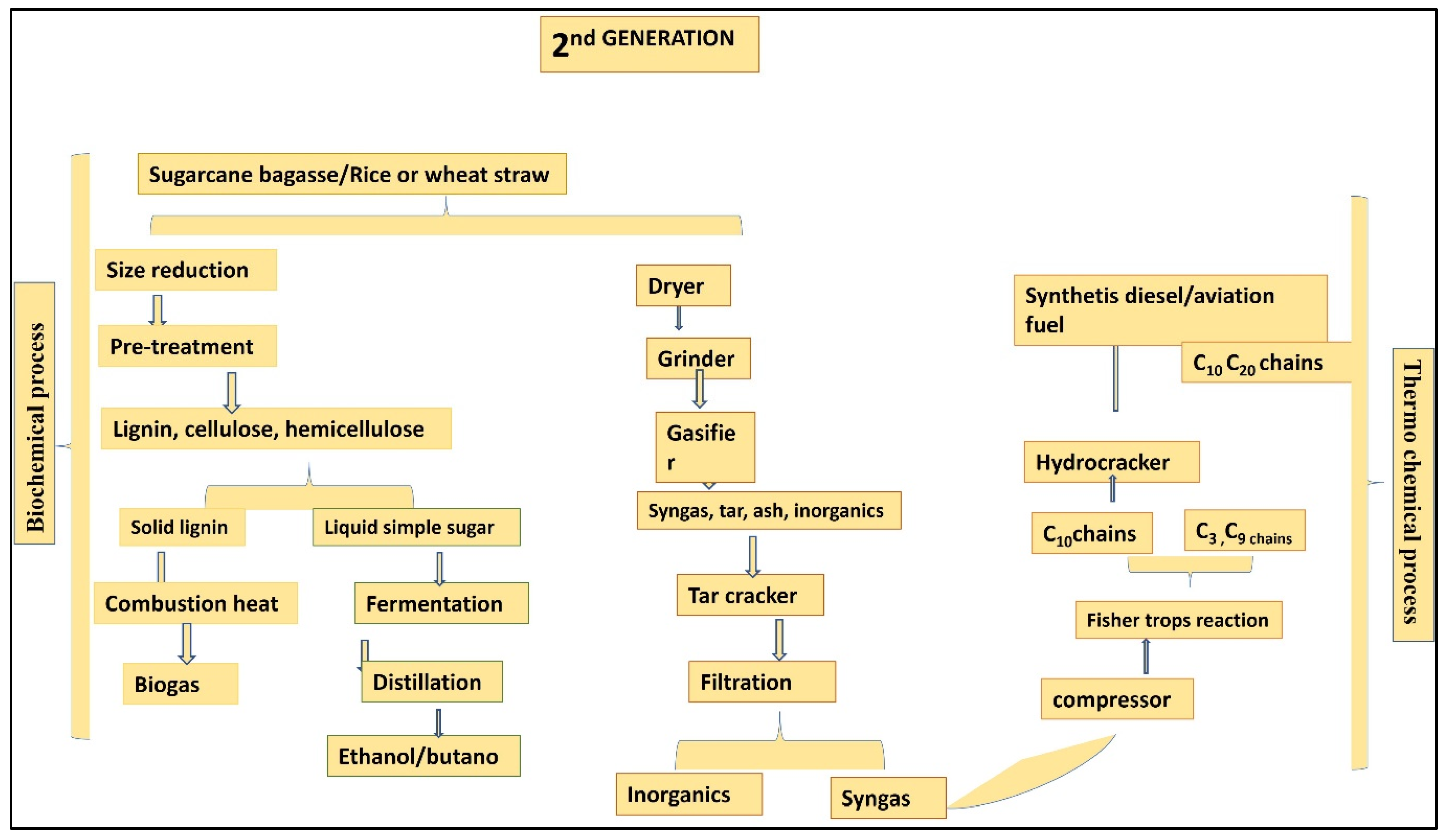

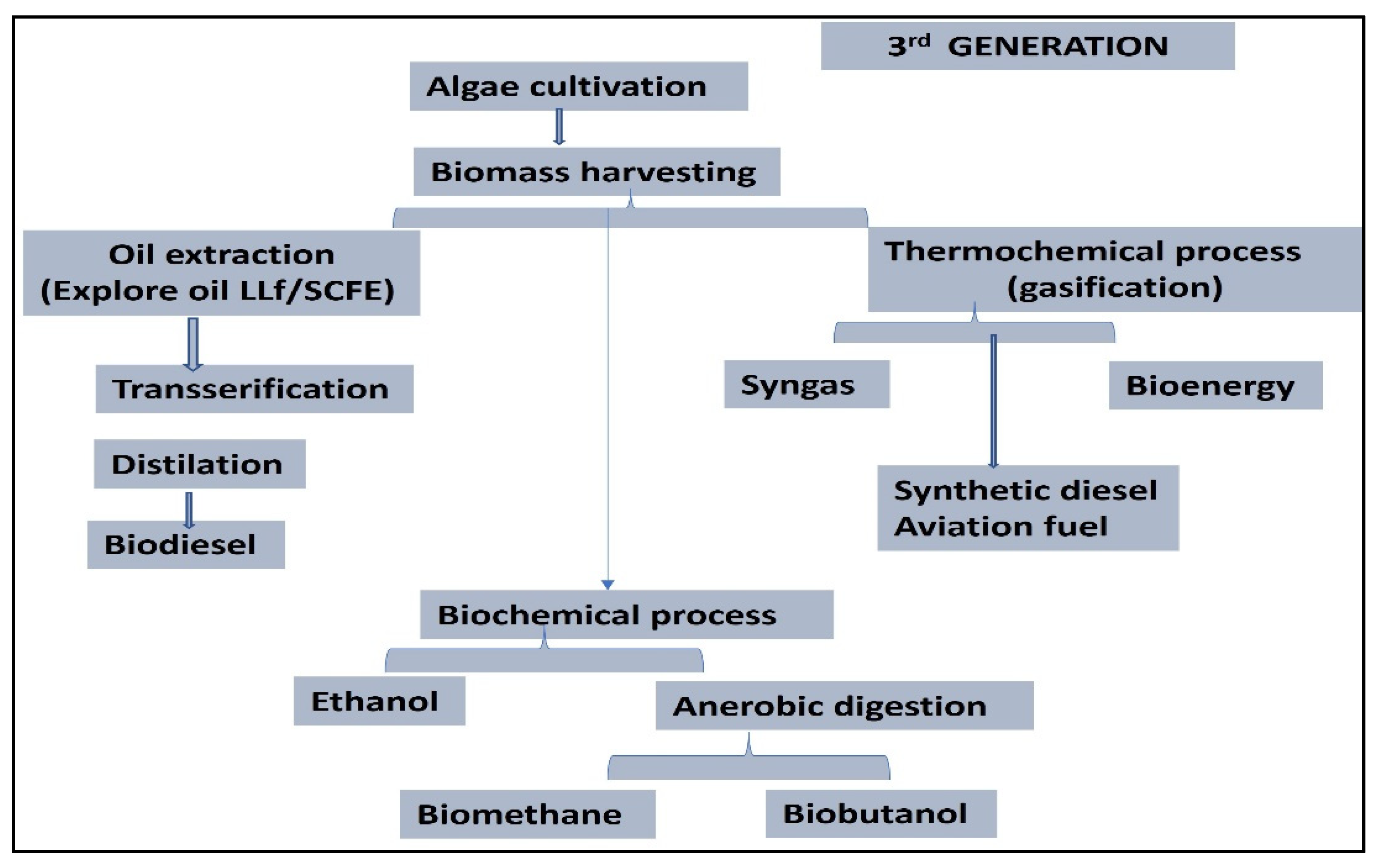
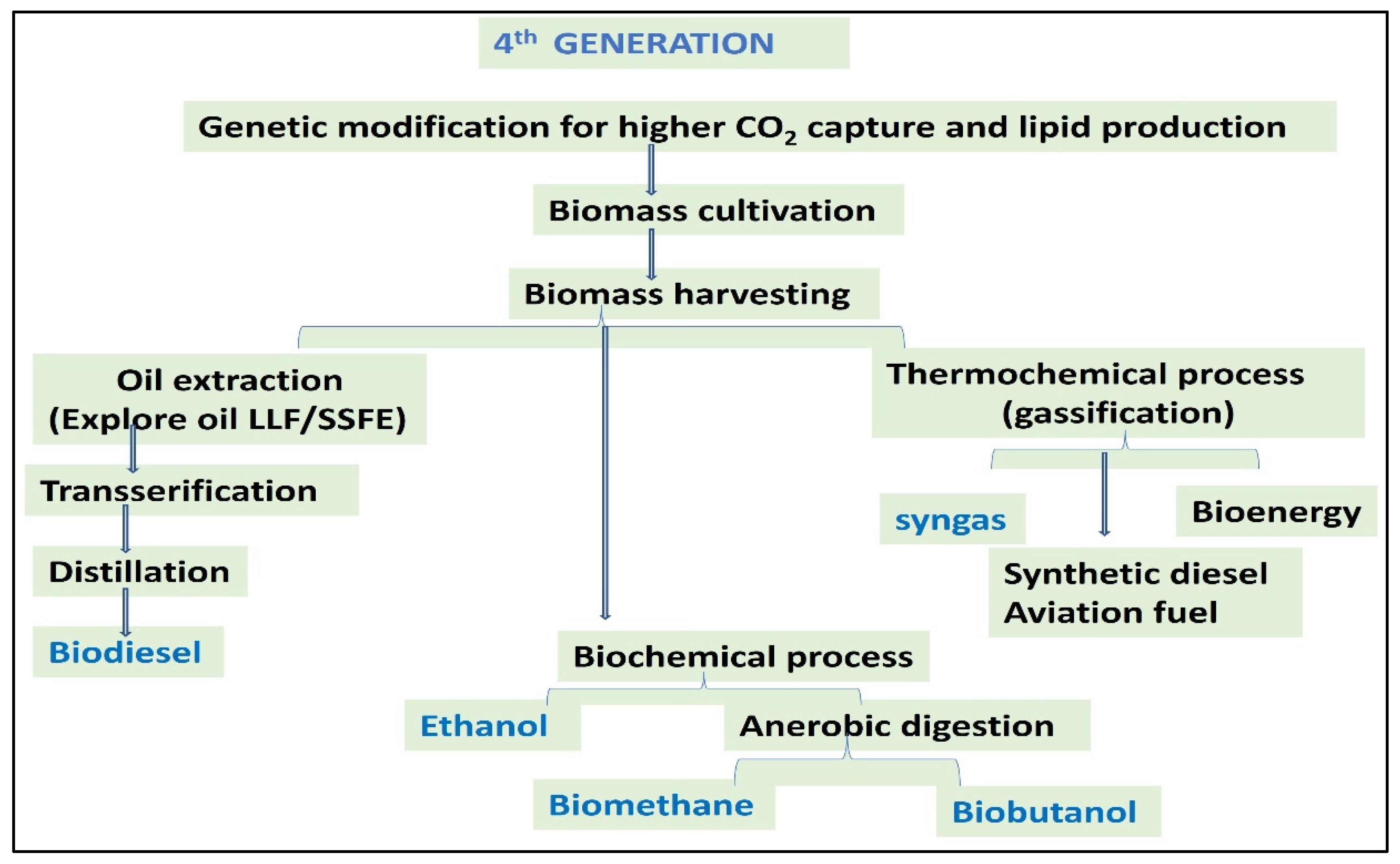
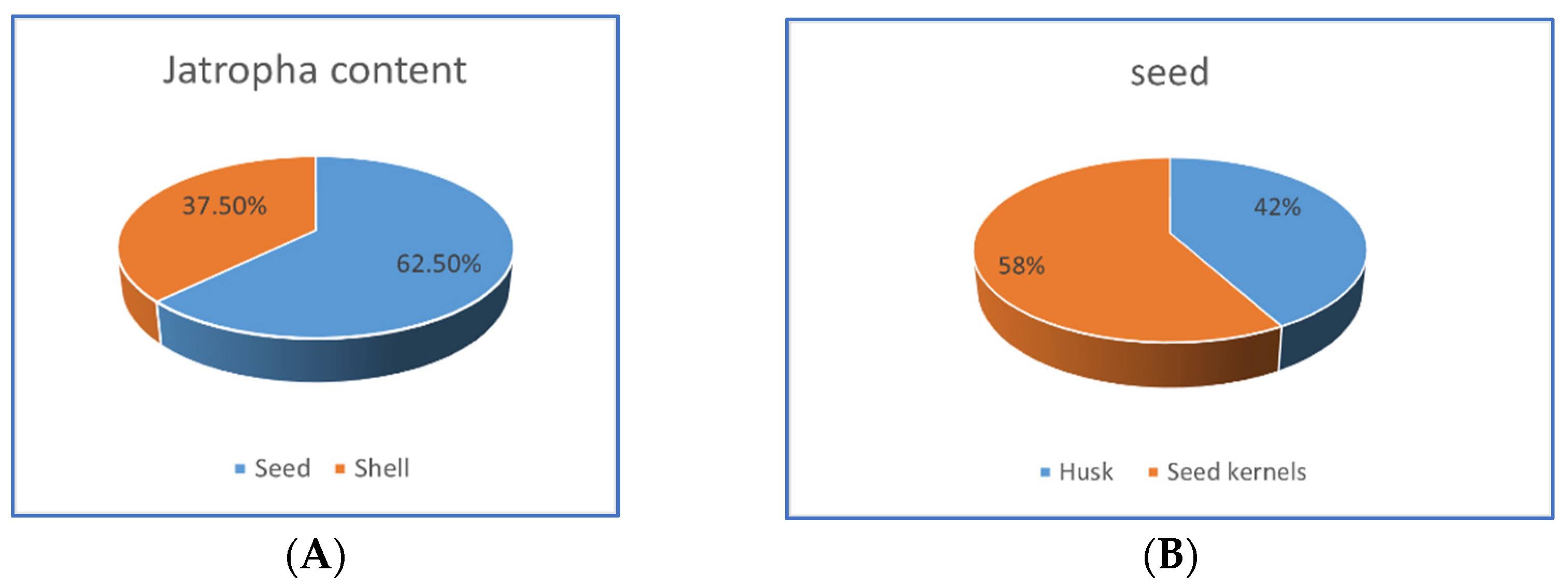
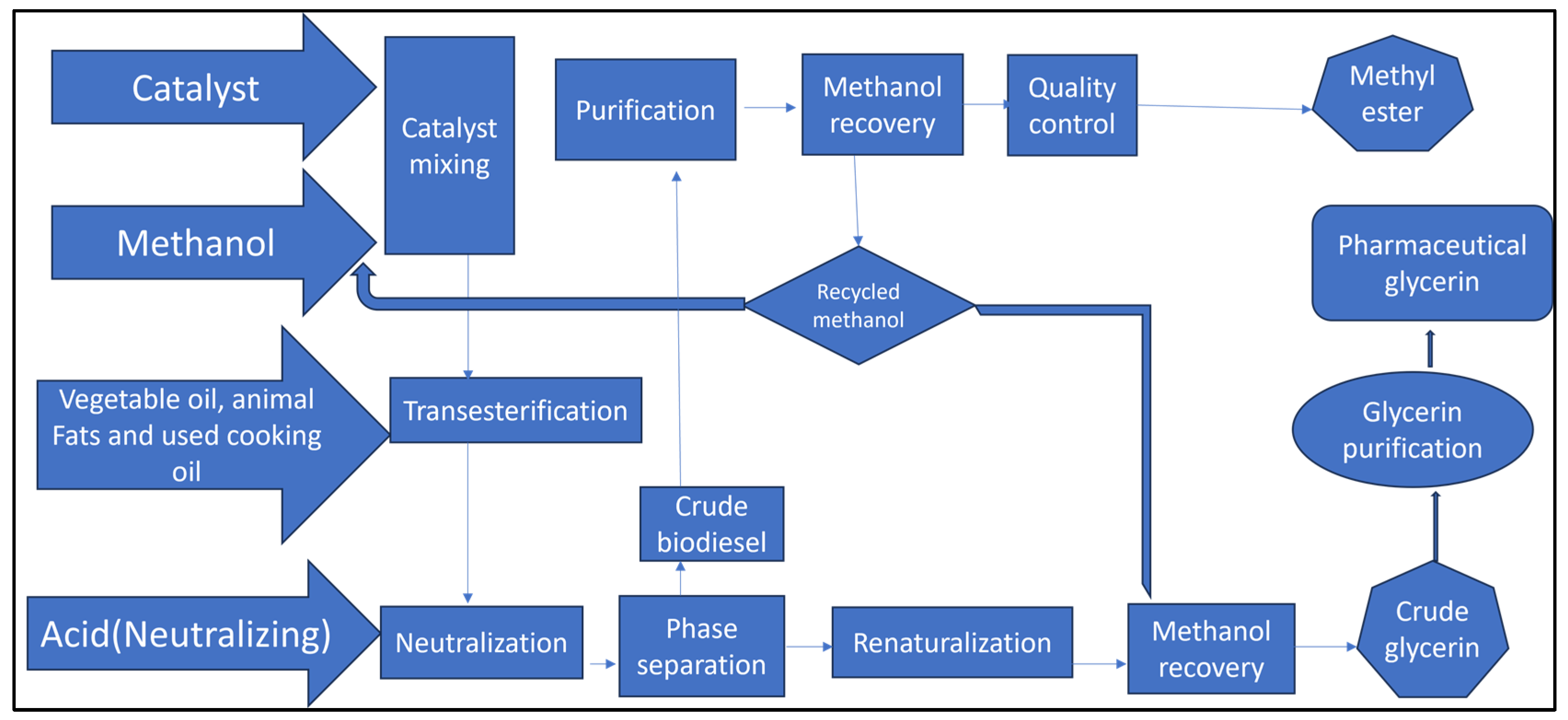
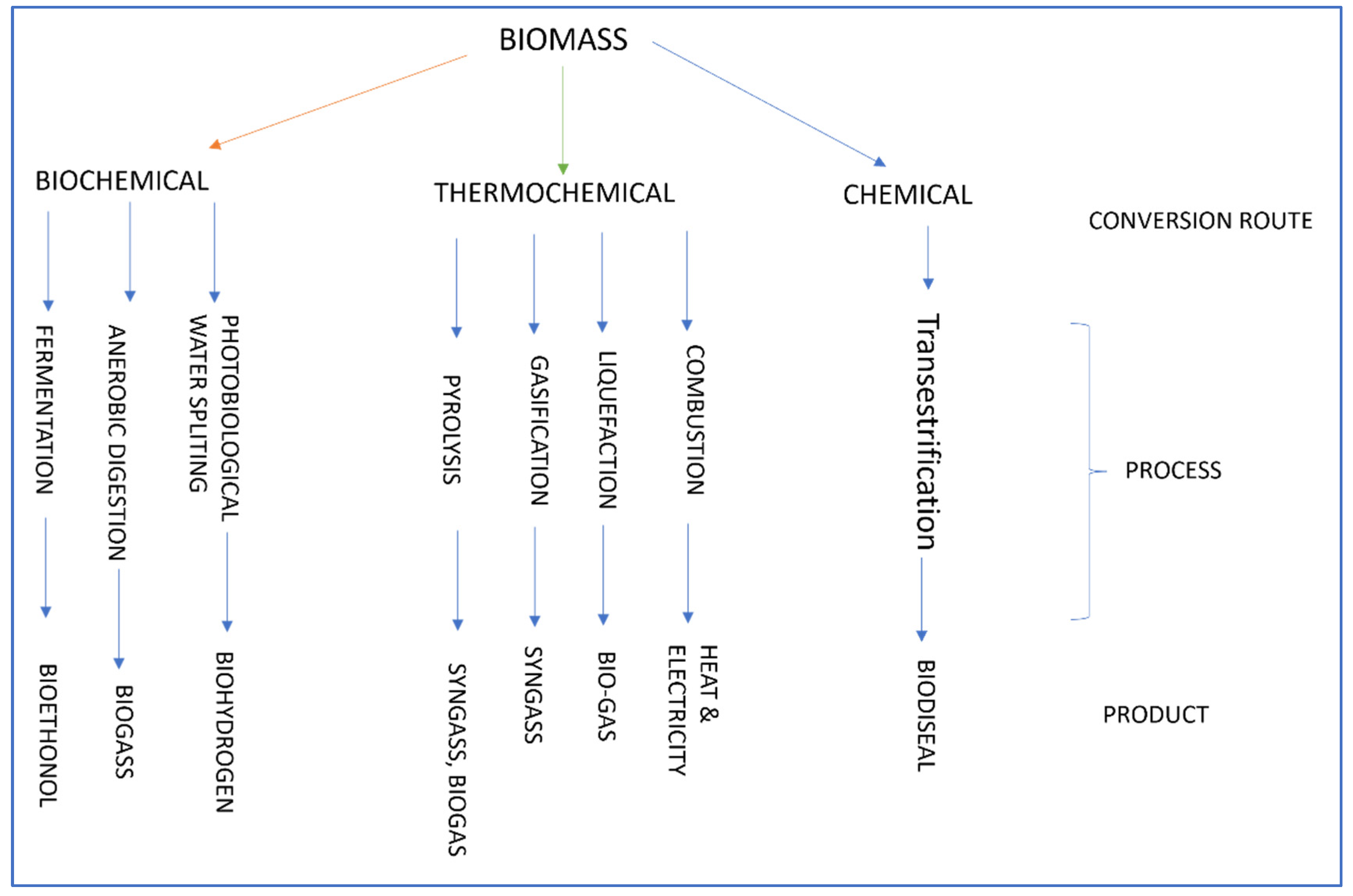
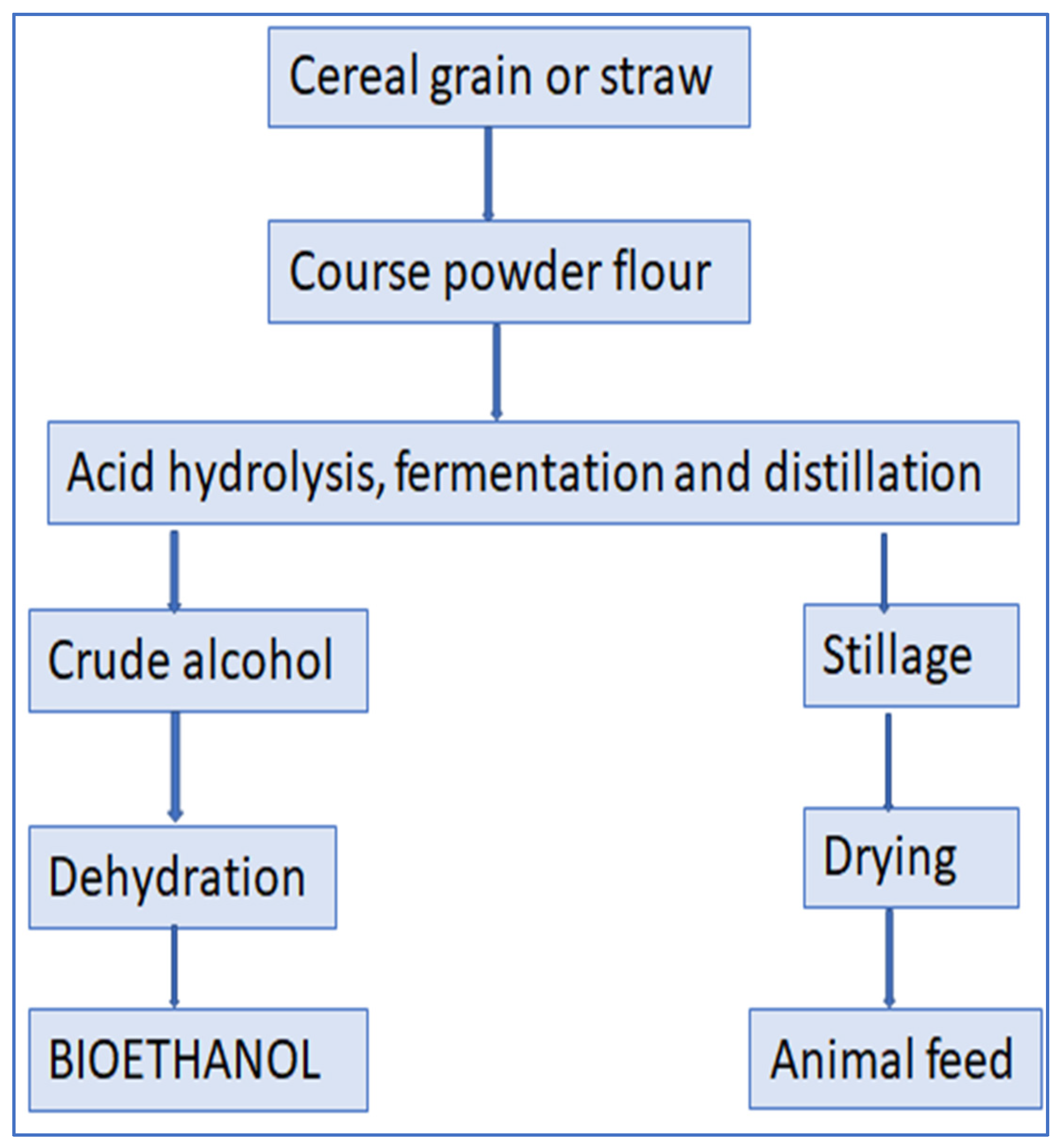
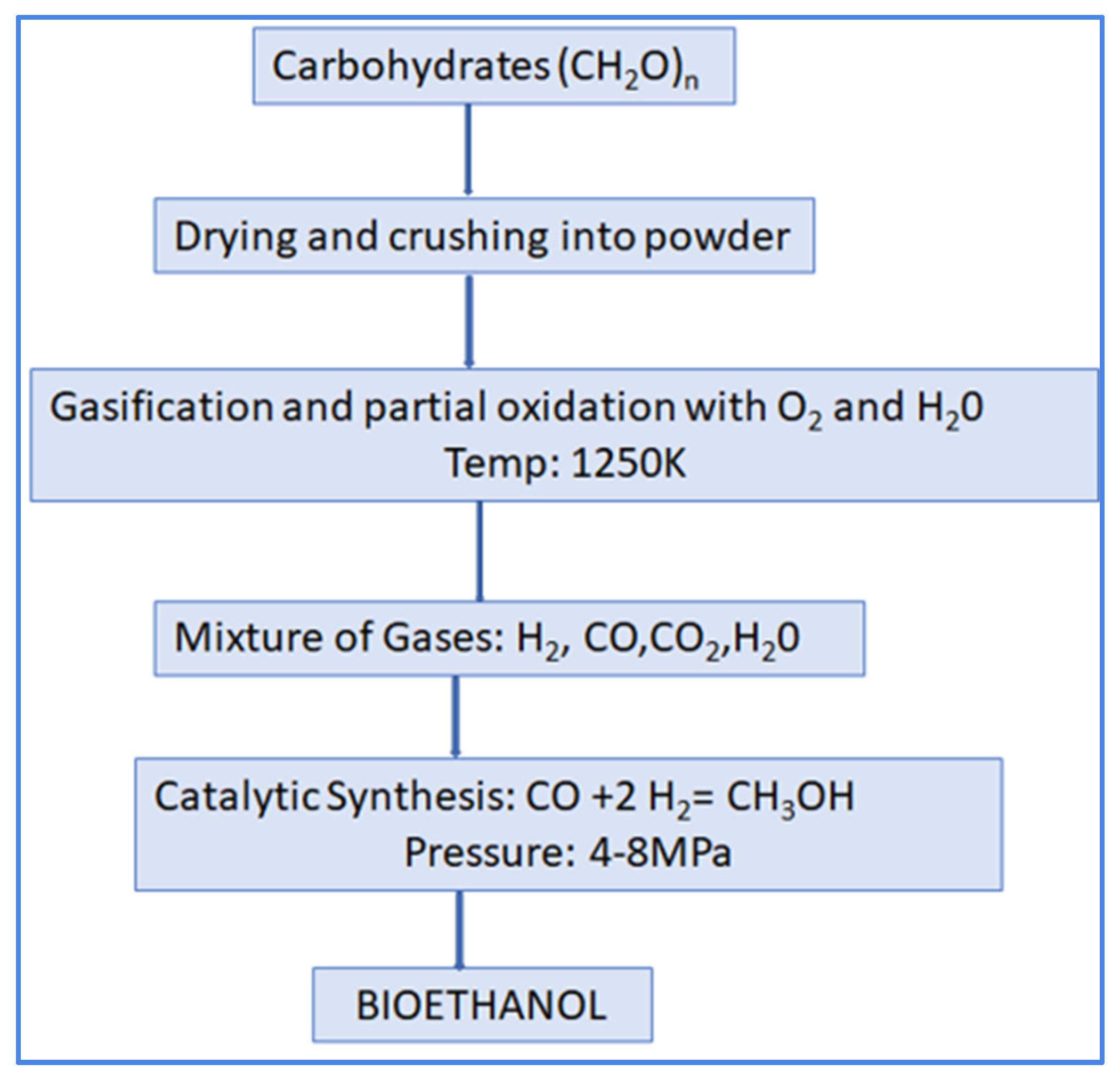
 |  |  |  |  |  |
| Corn | Soybean | Switchgrass | Saccharum officinarum | Sorghum | Wheat |
| Biofuel | Energy Crop | Yield | References |
|---|---|---|---|
| Bioethanol | Sugarcane | 71.9 g/L | [57,58] |
| Butanol | Sorghum and Sugarcane | 8.0 g/L | [59] |
| Biohydrogen | Sugarcane | 0.73 mol H2/mol hexose | [60] |
| Bioethanol | Corn and Grain | 121.52 g/L | [61] |
| Bioethanol | Maize | 137.50 g/L | [62] |
| Biohydrogen | Maize | 133 mL H2/g corn | [63] |
| Biofuel | Nanomaterial Used | Feedstock | Ref. |
|---|---|---|---|
| Biodiesel | Iron oxide NPs | Waste cooking oil | [105] |
| Ca/Fe3O4@SiO2 | Sunflower and Soybean oil | [106] | |
| Amino-silane modified Fe3O4 NPs | Rapeseed oil | [107] | |
| ionic liquid onto Fe3O4 @HKUST-1 | Soybean oil | [108] | |
| Fe2O3 NPs | microalgae | [109] | |
| Fe3O4/Au | Tomato seed oil | [110] | |
| K2CO3/γ-Al2O3/Sepiolite/γ-Fe2O3 monolith | Soybean oil | [111] | |
| Na-modified-SBA-15 | Sunflower, jatropha and waste cooking oil | [112] | |
| Functionalized Fe3O4 NPs | Microalgae | [113] | |
| CuO NPs | Mustard and waste cooking oil | [114] | |
| Sr–Ti mixed metal oxides | Waste cooking oil | [115] | |
| Diesel | Ni, Cu, Zn, Co, and Mn supported zeolite Y | Triolein | [101] |
| Bioethanol | Pd on C, Pd on alumina, silica NPs, alumina and Fe3O4 NPs | Syngas | [116] |
| MnO2 NPs | Sugarcane leaves | [100] | |
| CoFe2O4@SiO2–CH3 NPs | Syngas | [117] | |
| SiO2 NPs | Cheese whey | [118] | |
| NiO NPs | Glucose, potato peel waste | [99] |
Disclaimer/Publisher’s Note: The statements, opinions and data contained in all publications are solely those of the individual author(s) and contributor(s) and not of MDPI and/or the editor(s). MDPI and/or the editor(s) disclaim responsibility for any injury to people or property resulting from any ideas, methods, instructions or products referred to in the content. |
© 2024 by the authors. Licensee MDPI, Basel, Switzerland. This article is an open access article distributed under the terms and conditions of the Creative Commons Attribution (CC BY) license (https://creativecommons.org/licenses/by/4.0/).
Share and Cite
Shweta; Capareda, S.C.; Kamboj, B.R.; Malik, K.; Singh, K.; Bhisnoi, D.K.; Arya, S. Biomass Resources and Biofuel Technologies: A Focus on Indian Development. Energies 2024, 17, 382. https://doi.org/10.3390/en17020382
Shweta, Capareda SC, Kamboj BR, Malik K, Singh K, Bhisnoi DK, Arya S. Biomass Resources and Biofuel Technologies: A Focus on Indian Development. Energies. 2024; 17(2):382. https://doi.org/10.3390/en17020382
Chicago/Turabian StyleShweta, Sergio C. Capareda, Baldev Raj Kamboj, Kamla Malik, Karmal Singh, Dalip Kumar Bhisnoi, and Sandeep Arya. 2024. "Biomass Resources and Biofuel Technologies: A Focus on Indian Development" Energies 17, no. 2: 382. https://doi.org/10.3390/en17020382
APA StyleShweta, Capareda, S. C., Kamboj, B. R., Malik, K., Singh, K., Bhisnoi, D. K., & Arya, S. (2024). Biomass Resources and Biofuel Technologies: A Focus on Indian Development. Energies, 17(2), 382. https://doi.org/10.3390/en17020382








